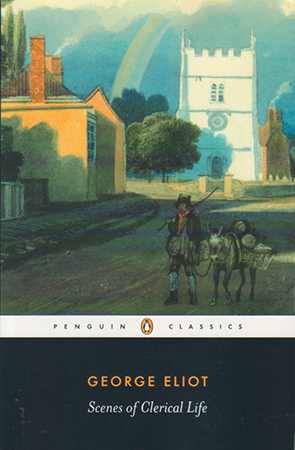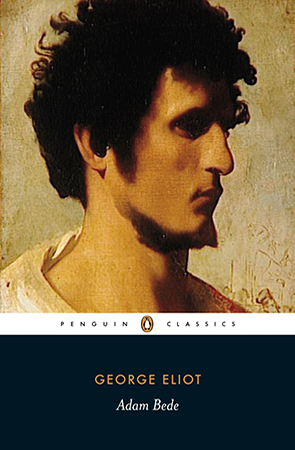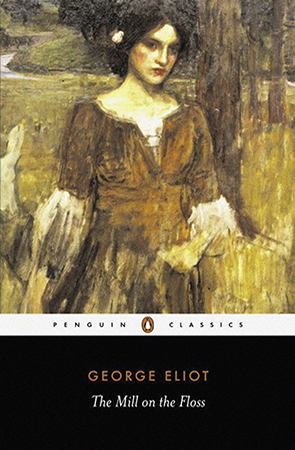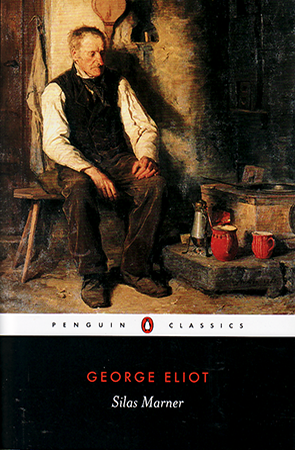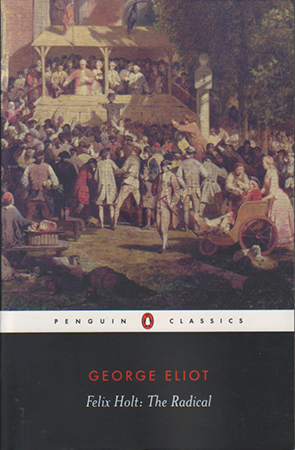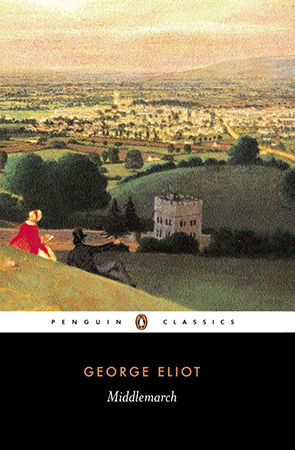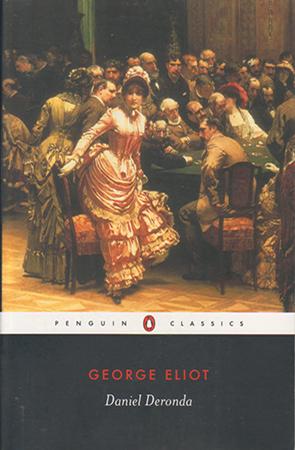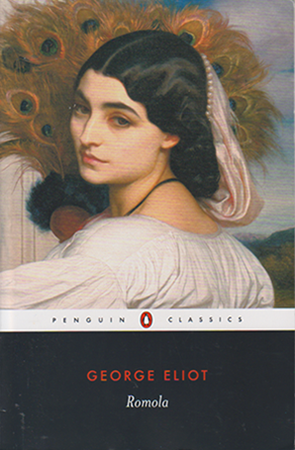
Full Title
- Romola
Key Publications
- Serialised in 14 parts for Cornhill Magazine from July 1862 until August 1863
- First Edition published in three volumes by Smith, Elder and Co, 1863
- The Romola Cabinet Edition, published by William Blackwood and Sons, 1878
Review Edition
Eliot, George, Romola, London, Penguin Books, 1996
Introduction: Dorothea Barrett
No. of Pages: 583 (641 with notes)
Review
Reviewer: bikerbuddy
Category: 19th Century Fiction, Historical Fiction
Date Read: 14 August 2025


Category: 19th Century Fiction, Historical Fiction
Date Read: 14 August 2025
Reviewer: bikerbuddy

Please Note: There are features in this review which can only be viewed on a wider screen.
Romola stands apart from George Eliot’s other fiction as her only novel not set within the relatively recent past of Victorian England. Romola is set in Renaissance Italy, during the period of the Borgia Pope, Alexander VI. The invasion of Charles VIII of France and the expulsion of the Medici family from the city give rise to Girolamo Savonarolo, a Dominican friar who inspires a large following through the power of his preaching, and commands political power within Florence. He demands religious and political reform and is highly critical of Pope Alexander VI, whom he says is illegitimate. Savonarola is eventually excommunicated, loses popular support, and is executed.
Romola, Eliot’s fictional character, is a young Florentine girl living with her father, Bardo de’ Bardi, in Florence. This is the same Bardi family that made its fortune in banking in the 14th century. But the family was bankrupted when Edward III of England, who had borrowed heavily to help finance the Hundred Years War, defaulted on the loan. Bardo’s life has been fulfilled by scholarship, instead. He owns an impressive library which he intends to bequeath to the state, along with a collection of valuable antiquities. But he has lost his sight and he relies heavily upon Romola to help him continue his work. She has learned Greek and Latin to help him. Nevertheless, he disparages the efficacy of her intellectual contributions because she is female. When Tito Melema, a young Greek scholar who is shipwrecked on the shores of Italy, wishes to pursue his ambitions in Florence, he is directed to Bardo whom he is told can provide him with an introduction to a buyer for his gems. Tito seems a perfect fit for the family. Not only is he capable of helping Bardo with his academic pursuits, and perhaps even capable of protecting Bardo’s intellectual legacy, he is also a highly attractive young man who turns Romola’s head, and she, his. Romola’s godfather, Bernardo del Nero, a staunch Medicean, does not trust Tito, but Bardo willingly gives his blessing to the inevitable marriage to come.
George Eliot’s least popular novel
George Eliot nominated Romola as one of her greatest achievements: “There is no book of mine about which I more thoroughly feel that I could swear by every sentence as having been written with my best blood, such as it is, and with the most ardent care for veracity of which my nature is capable.” Yet sales of the novel did not reflect her enthusiasm. It took a year to sell just over 1700 copies, whereas her previous novel, The Mill on the Floss, sold 6000 copies within the first two months of publication. Romola wasn’t widely popular, even though it garnered critical support. Unlike her previous novels, it was first published in as a serial in monthly instalments in Cornhill Magazine from July 1862 until August 1863. This gave Victorian novelist Anthony Trollope, who read the first chapter, an opportunity to respond, “Do not fire too much over the heads of your readers.” The intellectual weight of the novel – its meticulous research and detail – was evident to early critics. The Saturday Review said, “She loads the book with too much antiquarian detail in her attempt to gain historical perspective.” For the Athenaeum, Romola, as a serial, was not attractive: the minuteness of its historical detail wearied. The reviewer of the Athenaeum wrote, “Neither the politics nor the people of the book are alive; they are dried and preserved.” The reviewer continued, “As a novel, Romola cannot be called entertaining”, and concluded, “It has not the powerful interest that is to be found in the author’s other novels, but there are indications of much higher powers of mind.”
There are a couple of possible reasons for this reaction. First, Eliot had undermined her audience’s expectations by writing a novel with a markedly different socio-historical setting to her previous books. In fact, it is credited as being the first novel set in Renaissance Florence, so for Eliot’s contemporary audience, it was very novel, indeed. As a result, the book makes demands on the reader, particularly on Eliot’s contemporary readers who would have been more familiar with the near-contemporary past of her previous books, all set in England. This is part of the point of the Proem, the preface to the novel that introduces the reader to the world of Renaissance Florence: that it seeks to overcome these obstacles her reader might face. The ‘Spirit’ that Eliot evokes, a dead Florentine whom the reader will be guided by to tour the city, serves to show us that “we still resemble the men of the past more than we differ from them”.
Also, the book is evidently learned, as Trollope suggested. Eliot twice travelled to Italy with George Henry Lewes, her partner. Their first trip in 1860 helped inspire the subject for the story. They undertook a second trip in 1861, during which, Eliot writes, they spent thirty-four days researching the subject matter for the novel. They researched the historical period in libraries. They also toured the city, and Lewes even entered monasteries where women weren’t permitted so that he could make extensive notes for Eliot on frescos by artists like Fra Angelico. The streets and churches of Florence – its history and the high culture it produced, in terms of its intellectual and artistic achievement – would help Eliot construct the mise en scene of her novel.
Romola’s reputation as Eliot’s most difficult and least popular novel remains. And so, starting from this position, it is possibly more fruitful to accept that fact and lay it aside and consider, instead, what appeal the novel may have for modern readers who are possibly more familiar with the its historical setting due to the plethora of books, documentaries, websites, films and television, now available. And if we aren’t familiar with the period, it is easier for us to access this information. As modern readers, I suggest, it is easier to look past the foreignness of place and time, and more fully appreciate Eliot’s story, as well as what it has to say.
Romola’s Journey
Romola is a young woman raised by her father with an education normally only given wealthy young men during this period. Bardo, her father, is grateful for her help with his academic work after he loses his sight. Romola remains cloistered in her father’s house as his assistant, but when Tito Melema arrives, Bardo sees the potential for the renewal of his work and reputation, since he believes an academic life is, “less reconcilable with the wandering vagrant propensity of the feminine mind than with the feeble powers of the feminine body.” Bardo laments, “with my son to aid me, I might have had my due share in the triumphs of this century.” Bardo’s son, Dino, has entered into religious orders and is now known as Fra Luca, a Dominican friar. Bardo is estranged from his son as a result of this desertion. As for Romola, Bardo describes her as, “my sweet daughter” but he deems the intellectual support she offers to be limited to the “lower notes of the flute”. His academic reputation has languished due to his blindness, and without a son, “There will be nothing else to preserve my memory and carry down my name as a member of the great republic of letters – nothing but my library and my collection of antiquities.” Romola unselfishly devotes her time to the care of her father and helping him maintain some semblance of the academic life he once enjoyed. But Bardo places the happiness of his daughter and the security of his legacy in Tito’s hands.
From these circumstances, alone, the potential of Romola as a feminist narrative should be clear to modern audiences. Although, we should be careful to what extent we attribute Romola’s journey from her father’s house at the beginning of the novel to a level of autonomy at the end as representative of modern feminist experience. Romola’s journey is not only circumscribed by the limitations placed upon her as a woman, but also by the intellectual and spiritual parameters within which she lives, and therefore the scope she has to define her own moral relationship with the world.
As modern readers we understand there is a difference between more progressive 21st century attitudes, attitudes in Eliot’s society, and the accepted norms facing a girl like Romola. Social and moral attitudes in the 19th for instance, held that Eliot’s relationship with Lews outside of marriage was somewhat shocking, and her struggles with faith would also be of greater note then, than now, but then, Eliot also lived in a period when the authority of the church seemed shakier than portrayed in her novel. Darwin’s Origin of Species had been published in 1859. Allusions to that work had already appeared in Eliot’s previous book, The Mill on the Floss. But apostasy, agnosticism, atheism or divergent views about humanity’s relationship with the divine were still a difficult position to embrace.
But this is an even more difficult proposition in Renaissance Florence. As a historical period we see the broad emergence of Humanist thought, of secular funding of the arts through families like the Medicis, of a renewed interest in Classical scholarship and attempts to question the authority of the Catholic Church. Martin Luther wouldn’t post his 95 theses on the door of the church at Wittenberg until 1517 – Romola begins in 1492, the day after the death of Lorenzo Medici, and ends in May 1509 – but Savonarola was later acknowledged by Luther as a forerunner of the challenges made against the authority and credibility of the Catholic Church during the Reformation to come. Savonarola challenged the Church over its moral practices and corruption, but his resistance was institutional, as much as it cost him personally. But for Romola, as the novel’s titular protagonist, and as a woman, the question of resistance and change can only occur within the personal sphere, circumscribed by social and familial expectation and the Church. As a modern audience we may expect Romola’s journey will reflect modern expectations, but the world she inhabits is not our own, not even Eliot’s.
Florence’s artistic, political and commercial success makes it a poster child for the Renaissance, but its culture is still founded upon Medieval thinking and customs. Savonarola’s famous attempt to cleanse Florentines of worldly corruption by burning valuables, clothing, works of art and even books, in what became known as ‘the bonfire of the vanities’, was not a progressive break with the Catholic Church or questioning of church corruption and superstitions, as we see in the later Reformation, but a conservative hearkening back to religious doctrines and social standards he believed had been corrupted by a more secular government under the Medicis, and an attempt to challenge the power of a wayward pope. This is still a world in which monasteries and religious learning holds sway over a large portion of the population. There is a wonderful story in chapter 42 about the Tabernacle of the Madonna dell’ Impruneta, brought to Florence and stored in the Cathedral where it was hardly ever seen. The Madonna dell’ Impruneta was a religious painting purportedly found buried in a field. When a workman’s spade struck it, it was said to have cried out in pain. The painting was deemed to be miraculous. Eliot’s narrative tells us that for a century and a half the painting had protected the city from famine, pestilence and other maladies. While Europe was embarking upon a period of exploration – Columbus begins his famous voyage towards the Americas in the opening year of the novel – and undertaking scientific research, the vast bulk of society is still religious, subject to superstitious beliefs, and the Virgin Mary is a powerful symbol, still, as we shall see.
It seems evident – and it is a point widely accepted – that Romola represents less the reality of any Renaissance Florentine girl, and is more closely aligned with the character of Eliot, herself, as a female Victorianian intellectual. Romola’s intellectual learning reflects Eliot’s own, and Romola has been raised not as a Christian, but as a pagan, which makes her brother’s conversation and religious life that much harder for her to understand. Eliot, herself, had experienced a crisis of faith in her twenties and rejected many of the key tenets of the Christian faith at that time. The journeys of the author and her character are different, but they both have an unconventional relationship with Christianity and faith for their times. Through Romola, I would argue, Eliot seeks to define a moral ethos more attuned to the precepts of Humanist principles.
But first, let us acknowledge that Romola’s journey is defined within the parameters of patriarchal society. As a daughter, Romola is subject to her father’s authority. As a wife, she is subject to her husband’s. Later, she will even subject herself to the authority of Savonarola, who convinces her to return to Florence after she tries to leave Tito. He tells Romola that marriage, “is a sacramental vow, from which none but God can release you.” Yet the catalyst for Romola’s journey is not a bad marriage, per se, but the conflict between her patriarchal allegiances. Romola is committed to honour her father’s wishes: to secure his library and antiquities as a collection after his death, which will bear his name. However, this promise comes into conflict with her husband’s intentions. Tito sells her father’s library without her knowledge, to fund his own ambitions. It is an act which destroys Romola’s love for him. In reconciling her conflicted sense of duty, she finds it impossible to serve Tito’s goals with a good conscience.
Other relationships challenge her intellectual and moral precepts. On one hand, she has been raised by her father with pagan belief. On the other, she has other spiritual examples – her brother and Savonarola – who epitomise Christian ideals which seem foreign to her, but have a strong emotional and ethical pull: ideals of self-abnegation, self-sacrifice and charity. Having visited her brother in the Monastery of San Marco as he lay dying, and having received his prophetic warning against a marriage with Tito, Romola is open to a new intellectual direction that might underpin her moral impulses. The intellectual ‘springs’ which have fed her moral life have “all dried up around her”, and she,
would like to understand it – would even like to learn the thoughts of men who sank in ecstasy before the pictured agonies of martyrdom. There seemed to be something more than madness in that supreme fellowship with suffering.
So, when Romola meets Savonarola on the road out of Florence, intent on leaving Tito, she has already decided that she is entering a “new life – a life of loneliness and endurance, but of freedom”, which she imagines on some level to be a form of martyrdom. For Romola’s determination is to live a life of austerity and unhappiness, balanced by a sense of her own freedom. As she leaves Florence, she has an experience akin to St Paul’s own Damascene moment, which foreshadows her eventual sympathy with Savonarola’s teaching:
But presently the light burst forth with sudden strength, and shadows were thrown across the road [ . . .] The light is perhaps never felt more strongly as a divine presence stirring all those inarticulate sensibilities which are our deepest life, than in these moments when it instantaneously awakens the shadows. A certain awe which inevitably accompanied this most momentous act of her life became a more conscious element in Romola’s feeling as she found herself in the sudden presence of the impalpable golden glory and the long shadow of herself that was not to be escaped.
The light is like the light that falls upon St Paul. Suddenly, two monks appear: one of them Savonarola. Romola undergoes a kind of conversation, herself. She returns to Florence as instructed, where her efforts to help the poor and attend to those sick and dying of plague earn her the respect of Florentine citizens and the sobriquet, “Madonna”: she becomes, in fact, a ‘visible’ manifestation of the ‘unseen Madonna’.
Romola’s moral path
Romola’s trajectory, we might imagine, is towards religious revelation: that her story might become a hagiographic account of her life, perhaps leading to her beatification, even canonisation. And there was ample inspiration for this in Victorian culture. In the years leading up to Eliot writing Romola there had been popular interest in the Madonna as a seen presence. In La Salette near Grenoble in 1846 there were reports of sightings of the Virgin Mary by two children. One of the children, Melanie Calvet, claimed to have received revelations from the Virgin Mary. She later published them in a book. She was denounced by two priests as an imposter. But in 1858 Bemadette Soubirous reported to have seen the Virgin in a grotto at Lourdes. Unlike Melanie Calvet, Bernadette’s story was believed by the church and she was later canonised in 1933. A major difference between the two girls may be that, unlike Malanie Calvet, Bernadette Soubirous was not critical of Napolean III or his government. This is an observation I have taken from ‘Romola and Politics’ by Andrew Sanders, along with the story of the Madonna appearances. Sanders’ article considers Eliot’s contemporary history and how it relates to Renaissance Florence: the part Napolean III and France played in Italy during this period, attitudes to the pope, and the Italian Risorgimento – the Unification of Italy. The article is a good starting place. It’s an interesting subject but outside the scope of this review.
The Madonna is a major association with Romola, and given the widespread reportage of Bernadette’s story in the period before Eliot began her novel, it is likely that Eliot is deliberately referencing it in her portrayal of Romola. The second time she leaves Florence, Romola is cast upon a shore where she finds a village that has been overcome by plague. She finds a baby crying next to its dead mother, and as she carries the child to look for a well to give it water, the iconography of her religious garb combined with the child she carries is not lost on a young boy who first sees her: “She carries a pitcher in her hand – to fetch water for the sick. It is the Holy Mother, come to take care of the people who have the pestilence.”
Surely, Romola’s transformation into a saintly figure is virtually complete! Romola gathers those still surviving just outside the village. She directs them to bury the dead and clean up. Then she helps them to reestablish their lives. And when she must finally leave them, they beg her to stay.
But it is not a Christian spirit which has brought Romola to the village, nor does it direct her charitable actions. If Romola first helps the people of Florence after her Damascene moment, it is a far more secular inspiration that has brought her to this village, now. Savonarola gained influence over Romola because he represented a philosophy at odds with the self-serving attitudes of her husband. Savonarola was more aligned with the mysterious impulse of sacrifice her brother demonstrated. But when Romola’s godfather, Bernardo del Nero, is arrested for his Medicean sympathies, Romola receives little real sympathy from Savonarola. Savonarola is concerned not with humanity but a wider purpose that blinds him to her imprecations:
The end I seek is one to which minor respects must be sacrificed. The death of five men – were they less guilty than these – is a light matter weighed against the withstanding of the vicious tyrannies which stifle the life of Italy, and foster the corruption of the church . . .
Romola’s devotion to his cause has been predicated on practical action – helping those in need – while Savonarola is dedicated to a theoretical abstraction that has blunted his empathy: “The cause of my party is the cause of God’s kingdom”, he tells Romola. She replies, “God’s kingdom is something wider – else, let me stand outside it with the beings that I love.” Romola hears in Savonarola’s claims to a divine purpose the sound of egoism, which reduces him in her eyes.
Romola’s fortuitous journey to the plague-infested village is neither inspired nor directed by religious impulse. Rather, in a moment of supreme weariness with the world, after her godfather’s execution, she has decided to end her own life. She buys a small boat from a fisherman, hoping to drift out to sea. But she imagines her actions not in the manner of Christian martyrdom, an idea she was once drawn to, but through the story of Gostanza, a young woman from a tale in Boccaccio’s Decameron, who pushes out to sea in a small boat, also hoping to die. Boccaccio was a Humanist writer who questioned church practices, the veneration of saints, and individuals who used religion to manipulate others for personal gain. So, when Romola arrives in the village her good works are the result of her devotion to humanity, rather than devotion to a religious creed. Romola arrives in the village, having tried to kill herself,. The veneration shown her, characterised by the villagers as the work of a Madonna, is at odds with her prevailing moral progression towards a more Humanist approach to life.
Romola’s path, it seems, doesn’t lead from paganism to Christianity. Instead, she takes that path along her way to a more independent conception of a moral self, based on Humanist principles. Romola’s religious convictions have been especially fragile since she “felt her relation to the Church only through Savonarola”. Once Savonarola is found wanting, the church is reduced in her eyes from an institution “thrilling all hearts with the sense of great things, visible and invisible”, to a collection of hollow practices: “the slow, shuffling tread of monkish feet departing in the dim silence.” At this point, Romola has no guiding principle to undergird her moral impulses, which forces her back onto the question of “where the duty of obedience ends, and the duty of resistance begins”. It is a delineation of conscience required of all major characters in this novel. Tito meets it through self-deceiving rationalisations in the service of his own pleasure. Savonarola faces it in response to a society and a church he perceives as degraded and in need of reform.
For Romola, the question is resolved through the tenets of sacrifice – a common theme in church history – by taking personal responsibility in the service of others. By the end of the novel, when Romola has formed an all-female household (apart from children), she is asserting a belief in her freedom as a woman – an appealing thought to a modern audience – but she is doing that within the context of a moral code shaped by empathy and self-sacrifice, rather than religious doctrine:
It is only a poor sort of happiness that could ever come by caring very much about our own narrow pleasures. We can only have the highest happiness, such as goes along with being a great man, by having wide thoughts, and much feeling for the rest of the world as well as ourselves; and this sort of happiness often brings so much pain with it, that we can only tell it from pain by its being what we would choose before everything else, because our souls see it is good. There are so many things wrong and difficult in the world, that no man can be great—he can hardly keep himself from wickedness—unless he gives up thinking much about pleasure or rewards, and gets strength to endure what is hard and painful.
In fact, the epilogue of the novel acts as a fairly unsubtle coda for Eliot’s final position. As a counterpoint to this “hard and painful” road, is her criticism of the path chosen by Tito:
. . . if you were to choose something lower, and make it the rule of your life to seek your own pleasure and escape from what is disagreeable, calamity might come just the same; and it would be calamity falling on a base mind, which, is the one form of sorrow that has no balm in it . . .
I think Eliot’s epilogue asks us to look back at what we have read and understand her work as a series of parables about moral choices and the way we learn to live in the world. Tito has lived a life entirely for his own pleasure and advancement. He has refused the opportunity to rescue his father from slavery and he denies knowing him when he meets him in Florence, since Tito wishes to use money he has made from his father’s possessions to lead an easy life and get ahead in the world:
He had once said that on a fair assurance of his father’s existence and whereabout, he would unhesitatingly go after him. But, after all, why was he bound to go? What, looked at closely, was the end of all life, but to extract the utmost sum of pleasure? And was not his own blooming life a promise of incomparably more pleasure, not for himself only, but for others, than the withered wintry life of a man who was past the time of keen enjoyment, and whose ideas had stiffened into barren rigidity?
Tito’s plan that Romola leaves Florence with him is an easy one for her to reject. Tito is selfish, uncaring, deceptive and reveals that he has betrayed her father’s memory. Eliot has structured her tale as a series of progressions towards Romola’s fulfilment as an independent moral person. While writing The Mill on the Floss Eliot was rereading Paul Bunyan’s Pilgrim’s Progress, and the influence of that book as a model seems faintly evident in Romola, too. Other characters within the novel signpost Romola’s progress, like characters whom Christian meets in Pilgrim’s Progress. Christian’s is an everyman character journeying towards the ‘Celestial City’, a conception of heaven. On his journey he is waylaid and his faith challenged by false doctrine, worldly temptation and other false paths, until he finally reaches his destination. Like Mr By-Ends of Bunyan’s tale, Tito is a selfish man, only concerned about his worldly progress. Like By-ends, he is a hypocrite. He plays opposing political parties against one another to further his own cause. Tito believes in nothing except his own personal ambition and pleasure.
Likewise, Savonarola, while an influential mentor whom Romola can never fully reject, nor fully condemn, represents a kind of Mr Worldly Wiseman from Bunyan’s story, not because he advocates worldly benefits or secular wisdom – he does not – but because he provides a doctrine which is ultimately a distraction from Romola’s actualisation as an independent, moral being. Savonarola is tricked into participating in a trial by fire – claiming he could walk through fire unscathed – which only vacillation and a downpour of rain help him avoid. When it comes to a real test, Savonarola cannot help weighing his divine duty with temporal power. He is incapable of the selfless sacrifice that inspires Romola. But Eliot provides us with a wonderfully complex characterisation of him; a man who struggles with the greater sense of his own purpose, and the weaknesses of egotism and doubt that characterise his inner life.
Despite its reputation, I think Romola is a powerful and compelling novel, even now. Florence in the 15th century is a place that is alien to us, but accessible, because this is really a story about human beings, rather than a lesson in the minutiae of history, as early critics might have judges it. The moral complexity of its characters – even those like Tito whom we might initially think is easy to dismiss – serves to draw us in as readers, rather than repel us. In fact, Tito is the most fully realised character in the novel, so any first impulse to write him off as a bad piece of business is a mistake. Tito is alluring, persuasive, has strong impulses to act morally, and if we are not careful, we find ourselves being drawn into his self-deceptions. Tito, in fact, convinces himself of the righteousness of his cause, and this makes him so much more appealing within the narrative. I began Romola with an attitude that I must read it because I had decided I wanted to read all of Eliot’s fiction. So, there was a strong element of duty in starting. But it is a gripping tale which quickly immersed me in its world and the lives of its characters. The first part of the book is really only setting up the rest of the story, and I have seen some writers say it is a hard slog. I can only speak for myself when I say that I found the lives of the characters interesting, and the emerging situation that Eliot is shaping had me anticipating the rest of the book, like the slow ratcheting climb of a roller coaster at the beginning of its ride. So, early on, for me, reading was no longer a duty, but a pleasure. And apart from drama, which Eliot is adept at portraying, there is even a hilarious scene in chapter 16, which made me wonder whether I was about to read a variation of Banjo Pattison’s poem, ‘The Man from Ironbark’ about a barber who plays a practical joke on his out-of-town customer.
So, for modern audiences, Romola is a story about a young woman seeking a degree of independence to define her own life, but it is done within a religious and historical context that will seem less familiar to many. My best recommendation is to have some patience with the book, especially with the opening Proem, which speaks directly to Eliot’s contemporary audience more so than us, and then immerse yourself in the rest of the story. You may find yourself looking up some Italian words, or searching for information about the people or times that are represented in the novel to begin with. Most editions, now, should have good glossaries, information on historical personages and notes, like my Penguin edition of the novel. But as you read you will find the need to do this less and less. This seems evident in the notes in my Penguin edition, which diminish in length and number as the novel progresses. If you’ve read Eliot before and loved her writing, but have avoided Romola, you, especially, should give it a chance. My best recommendation, in the end, is that it is interesting and an entertaining read.
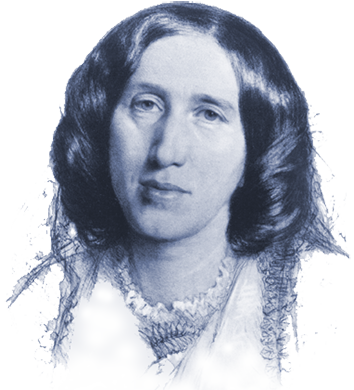
Renaissance Florence
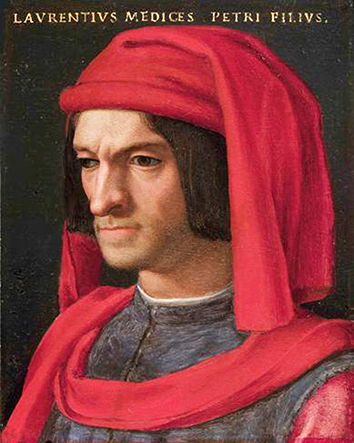
Lorenzo de Medici by Agnolo Bronzino, 1565
Lorenzo di Medici (1449 – 1492) was the head of the foremost family in Florence. He effectively ruled Florence through his connections, alliances, patronage and manoeuvrings. Romola begins the day after his death (9 April 1492), which leads to the weakening of Medici control in the city due to Lorenzo’s son, Piero di Lorenzo de’ Medici, who succeeded him but was not able to maintain the control his father had. Lorenzo’s death was a factor in the rise of Savonarola as a powerful voice in the city.
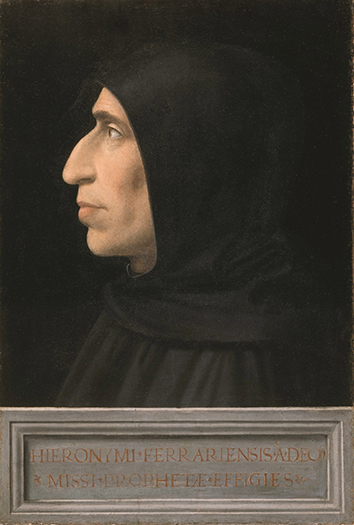
Savonarola by Fra Bartolomeo, 1498
Fra Girolamo Savonarola (1452 – 1498) was a Dominican monk who claimed to have visions from God. He gained influence after the invasion of Charles VIII of France, an event he claims to have foretold from a vision. The Medici family were also expelled during the invasion and Savonarola effectively gained political control in the city, even though he held no political office. He preached against the pope who was known to have children, and was banned from preaching in retaliation. When he disobeyed the ban, Savonarola was excommunicated from the Church. He is famous for encouraging Florentines to burn their books, their art and other secular valuables in what became known as the Bonfire of the Vanities. After he lost popular support, he was eventually executed. This image of him, purportedly painted in the year of his death by Fra Bartolomeo, a follower of Savonarola, shows a man seemingly at peace. Eliot portrays a far more conflicted man, uncertain of his own choices and motivations.
A Latin inscription appears at the bottom of the portrait: ‘Hieronymi ferrariensis a deo missi prophetae effigies’. Translated, it says: ‘Portrait of Jerome of Ferrari, a prophet sent by God’. He was also known as Jerome Savonarola.
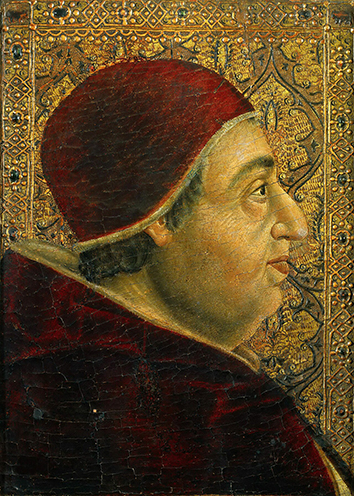
Pope Alexander VI (Rodrigo Borgia) by Pedro Berruguete, 1495
Pope Alexander VI (Rodrigo Borgia 1431 – 18 August 1503) Alexander Vi was one of the most controversial popes, partly because he acknowledged children he had fathered. His family name – Borgia – became a byword for libertine behaviour and nepotism. He supported his son’s military career. In the Second Italian War, Alexander VI supported his son Cesare Borgia as a condottiero for the French king, a military command. Machhiavelli’s The Prince speaks favourably of Cesare Borgia several times, and Machiavelli uses him as an example of an effective leader. Alexander VI was criticised by Savonarola, who believed he was an illegitimate pope due to his poor moral character and corruption. Alexander VI would eventually excommunicate Savonarola.
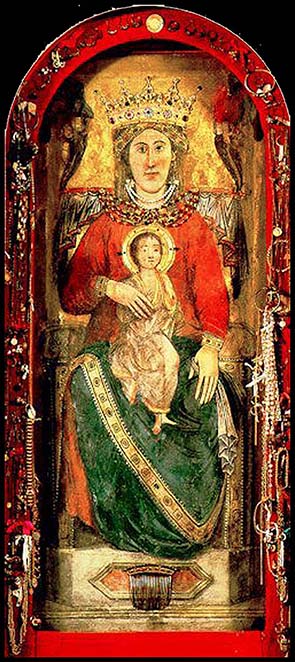
Madonna dell’ Impruneta
This medieval painting was reputedly found in a field sometime around 1060 CE. It was claimed to have produced several miracles, and a parish church dedicated to Santa Maria was constructed to house it. In 1496 it was paraded through the city in the hope that its miraculous powers would help to break a famine which was caused by interrupted supply lines due to weather, as well as Pisa’s war with Florence for independence, which was encouraged after Florence refused to join Alexander VI’s alliance Charles VIII of France. In Romola it is Tito who rides into the city to deliver the news that ships with food have landed at Leghorn, the seaport of Florence.
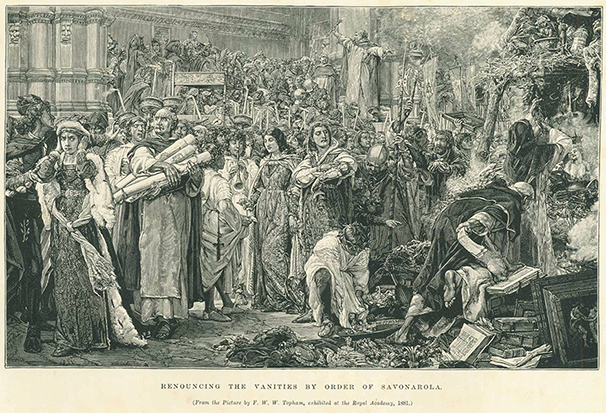
Bonfire of the Vanities
The Bonfire of the Vanities was a large bonfire fuelled by secular items of clothing, art and other belongings of Florence’s citizens that Savonarola deemed morally corrupting. In this engraving, taken from a painting by F.W. Topham, the crowd brings items to add to the stack of items at the right, which will fuel the bonfire.
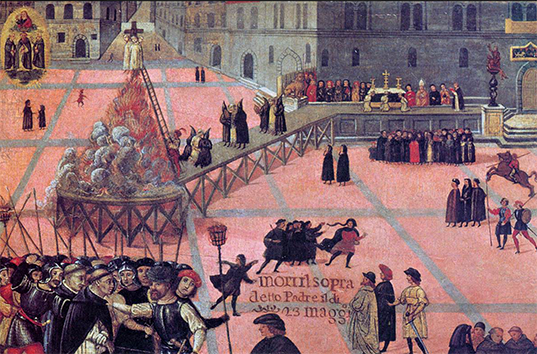
The Execution of Fra Girolamo Savonarola, May 22 1498
Savonarola was persuaded to accept a trial by fire, in which he was expected to miraculously pass through fire unharmed. It was a challenge to his credibility and his doctrines, but many believed he could do it. He lost credibility when he allowed another friar to offer to take his place. The trial went ahead, but arguments and delays, and eventually a heavy rain, caused it to be cancelled. Savonarola lost a lot of support as a result. The pope gave permission for him to be tortured on suspicion of sedition. Savonarola confessed, then recanted his confession and then confessed again after further torture. He was hanged and then burned along with two of his brethren in the Piazza della Signoria in Florence in 1498, as shown in this 16th painting. The painting appears to show different moments of the execution simultaneously. The three friars are evident, tied to the top of the pole over the fire at the centre of the painting. They also appear in white robes being led along the platform towards the fire. The building with the tower is the 13th century fortified palace, the Palazzo Vecchio, which still stands in Florence to this day. These towers were a common sight in Renaissance Florence. Eliot claims there were over seventy towers, other sources say over a hundred. Most are now gone.
